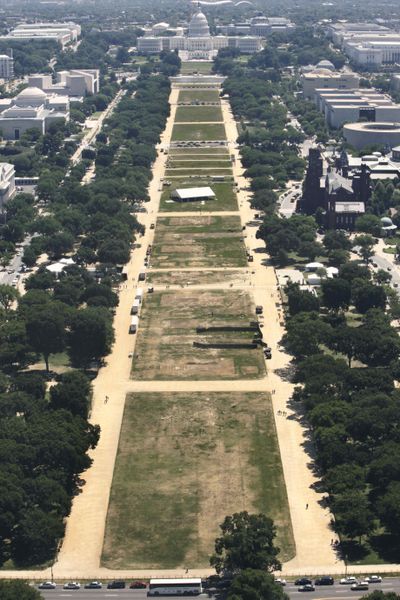Neglected National Mall languishes

WASHINGTON – Crumbling sidewalks near the Jefferson Memorial are sinking into the Tidal Basin. Reflecting pools are filled with green, smelly water. And millions of visitors have trampled the soil into virtual concrete where grass can’t grow.
The National Mall is in danger of becoming a national disgrace.
“It does not deserve the name ‘National Mall,’ ” said Delegate Eleanor Holmes Norton, the city’s nonvoting member of Congress. “We ought to call it something else until it looks decent.”
The Obama administration recently steered $55 million in economic stimulus money toward repairs, but Interior Secretary Ken Salazar said that’s only a down payment on the nearly $400 million needed to fix up a national park that draws more visitors than Yellowstone, the Grand Canyon and Yosemite combined.
The mall is in Washington, D.C., which has no vote in the House or Senate.
Last year, when dozens of ducks and ducklings died of avian botulism because the water in a mall pool near the Capitol was so fetid, and as urgent repairs were needed to stop the Jefferson Memorial’s sea wall from sinking into the mud, the Senate killed a $3.5 million earmark for the mall.
Instead, funding went to projects back home. All told, Congress sent home more than $181 million in earmarks through the park service budget last year – an election year – according to data compiled by the group Taxpayers for Common Sense and analyzed by the Associated Press.
Earmarks are used to boost projects both large and small. In 2008, there was $20 million for dam removal at Olympic National Park in Washington state with help from Rep. Norm Dicks, D-Wash., who oversees park service funding; Sen. Robert Byrd, chairman of the Senate Appropriations Committee, sent more than $3.3 million home to West Virginia, including $123,000 to restore a Mother’s Day Shrine. Lawmakers sent millions more home to restore county courthouses and local historical sites that aren’t even part of the national parks.
The mall didn’t just lose out on earmarks. In January, Congress deleted $200 million in stimulus funding for the mall. And last year, a bill that would have appropriated $100 million for mall repairs failed.
Republican Rep. Jeb Hensarling of Texas said mall funding wasn’t an emergency. “It’s entirely appropriate for Congress to fund repairs for the National Mall in the traditional process, but the American people are smart enough to know that it will do very little or absolutely nothing to provide economic stimulus,” he said.
House Republican whip Eric Cantor of Virginia similarly derided efforts to “help upkeep the grass on the lawns of Washington.”
Yet Congress invests in sod and flower beds on its own grounds at the Capitol, which are kept carefully manicured, even as the mall – which runs 2 miles from the Capitol to the Lincoln Memorial – has languished.
Congress employs about 1,900 workers to maintain its buildings and 450 acres, while the National Park Service has about 200 workers for the 650-acre mall and memorials.
Thousands of events, including festivals, protests and the Independence Day fireworks, play out on the mall. In January, the park service estimated 1.8 million people crammed into the area to witness the presidential inauguration.
Altogether, about 25 million visits are counted on the mall each year.
A public-private partnership might be what saves the mall. The nonprofit Trust for the National Mall, founded in 2007, aims to raise $500 million in about five years by targeting all Americans — from corporations to students visiting Washington.
So far, the group has taken small steps, such as securing private funds from Coca-Cola to launch the mall’s first recycling program. It could take 15 years to complete larger improvements, such as re-engineering reflecting pools to circulate water, laying new walkways to preserve grass and installing a sprinkler system to keep the mall green, said Caroline Cunningham, the trust’s president.
Many tourists say they can look past the mall’s flaws and that the powerful marble memorials and sweeping vistas continue to inspire. But a closer look shows it’s in shoddy shape.
The iconic reflecting pool at the Lincoln Memorial is surrounded by dirt, the grass worn away by visitors, and the water is stagnant.
At nearby Constitution Gardens, some granite walls surrounding a lake are collapsing into the water, and walkways are badly cracked and uneven, with craters full of mud. Bathrooms are rare, and those that exist tend to be filthy.